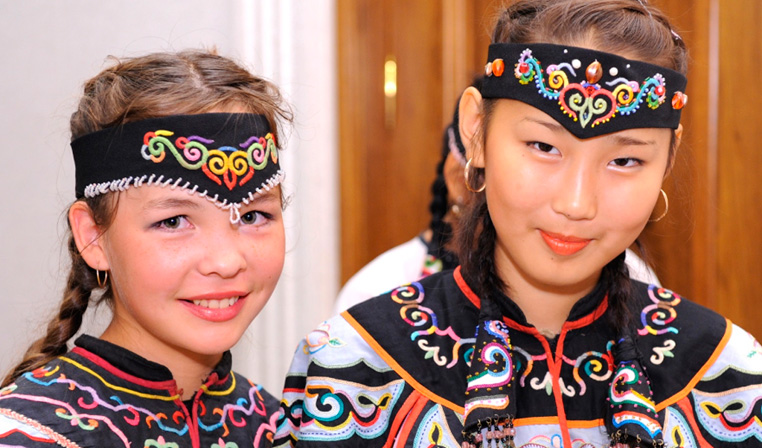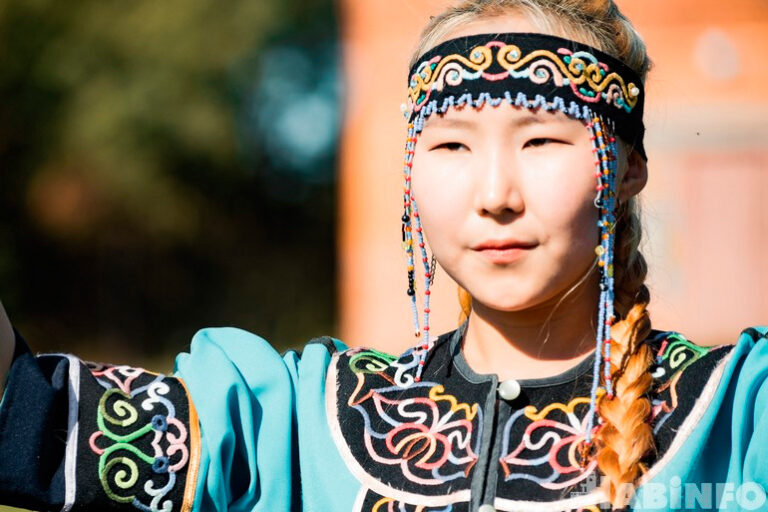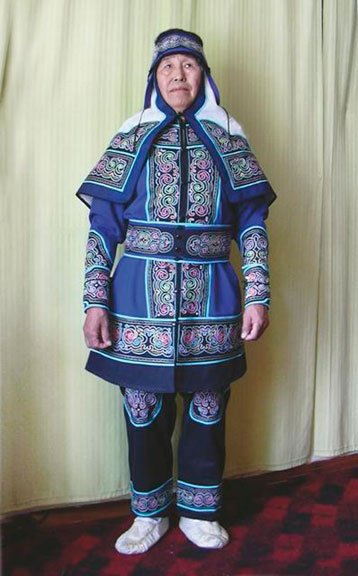Nanai



Nanai — самый многочисленный народ из числа коренных народов юга Дальнего Востока. Относится к тунгусо-манчжурской языковой группе.
Самоназвание — нанай, нани, («местный, здешний человек»). В некоторых территориальных группах бытовали такие самоназвания, как килэ, акани, хэденай и др. Старое название нанайцев — гольды. По данным Всероссийской переписи населения 2020 года численность нанайцев в Хабаровском крае составляет – 1081 чел.
Historical referenceРяд исследователей (Л. Шренк, И. Лопатин и др.) считали, что родина нанайцев – в Маньчжурии, у подножья хребта Чан-бай-шан, откуда они спустились в долину Уссури и достигли Нижнего Амура.
Другой точки зрения на происхождение нанайцев придерживался Л. Я. Штернберг, считавший нанайцев конгломератом родов различного происхождения. На территорию Нижнего Амура, населенную уже в период неолита, в разные исторические периоды приходили небольшие группы тунгусов, тюрок, монголов, маньчжуров. Смешиваясь с местным автохтонным населением, они формировали различные этнические общности, одной из которых и стали современные нанайцы.
Нанайские роды Киле, Самар, Дигор, Гайер, Хайтанин имеют эвенкийское (тунгусское) происхождение. В составе нанайцев рода Бельды имеются айнские подразделения, именующие себя себякуями, а своим исконным местообитанием считают острова, откуда они и переселились на материк. В состав других нанайских родов вошли китайцы, маньчжуры, солоны, дючеры и другие народы. В свою очередь от складывающейся нанайской этнической общности откалывались периферийные группы, ассимилируемые соседними народами — ульчами, нивхами и др.
Historical reference
Ряд исследователей (Л. Шренк, И. Лопатин и др.) считали, что родина нанайцев – в Маньчжурии, у подножья хребта Чан-бай-шан, откуда они спустились в долину Уссури и достигли Нижнего Амура.
Другой точки зрения на происхождение нанайцев придерживался Л. Я. Штернберг, считавший нанайцев конгломератом родов различного происхождения. На территорию Нижнего Амура, населенную уже в период неолита, в разные исторические периоды приходили небольшие группы тунгусов, тюрок, монголов, маньчжуров. Смешиваясь с местным автохтонным населением, они формировали различные этнические общности, одной из которых и стали современные нанайцы.
Нанайские роды Киле, Самар, Дигор, Гайер, Хайтанин имеют эвенкийское (тунгусское) происхождение. В составе нанайцев рода Бельды имеются айнские подразделения, именующие себя себякуями, а своим исконным местообитанием считают острова, откуда они и переселились на материк. В состав других нанайских родов вошли китайцы, маньчжуры, солоны, дючеры и другие народы. В свою очередь от складывающейся нанайской этнической общности откалывались периферийные группы, ассимилируемые соседними народами — ульчами, нивхами и др.
Образ жизни
Первостепенное значение для нанайцев издревле имело рыболовство. В хозяйственном календаре нанайцев в названиях пяти месяцев упомянуты различные виды рыб, что говорит о важности для них рыбного промысла.
Характерная черта нанайского рыболовства — высокая специализация орудий промысла. В области ихтиофауны, знания мест обитания и путей миграции рыбы, нанайцы всегда считались непревзойденными знатоками.
Нанайские орудия рыбной ловли различаются в зависимости от вида рыб, места их обитания и приемов лова.
К числу простейших относятся рыболовные крючки уму, умэкэн. Широко использовались крючковые снасти-переметы на промысле калуги киутэл орги.
Колющие орудия у нанайцев представлены различными типами острог: чакпан — двузубая острога для добычи мелкой и средней частиковой рыбы; хосоли — острога с наконечником-стрелой от самострела для особо крупной рыбы, длина древка такой остроги достигала 20—30 м; дёгбо — острога, трезубый наконечник которой легко соскакивал с древка и повисал на длинном ремне, с помощью такой остроги нанайцы добывали крупного сазана, осетра, тайменя, ленка; элгу — острога с наконечником в виде крючка, жало которого направлено к древку, острогу опускали в воду и, высмотрев идущую рыбу, накалывали ее на крючок.
Из ловушечных орудий лова наибольшее распространение имела ловушка типа вентеря уки. Её плели из тальниковых прутьев, она представляла собой корзину с узким коническим горлышком.
Распространенным методом лова у нанайцев было запорное рыболовство. На Амуре строили заездки мэнгэн в виде двух заграждений, сходящихся друг к другу под углом, одно длиной до 300 м шло от берега в глубину реки, другое — параллельно берегу.
Наиболее совершенными орудиями промысла на Амуре были ставные и сплавные сети. С их помощью добывали основной улов.
Охотничий промысел некогда также играл в жизни нанайцев значительную роль. В многочисленных нанайских сказках и героических сказаниях герои занимаются в основном охотой. Охотничий промысел нашел свое отражение и в хозяйственном календаре нанайцев. Так сентябрь назывался у нанайцев потканко биа, т. е. месяц, когда ловят зверей петлями. Охота обеспечивала нанайцев мясом и пушниной.
Интересный факт
Поселения нанайцев были двух типов: постоянные и сезонные. Сезонные стойбища назывались ирга. Часто их сооружали на островах, которыми особенно богат Амур. Постоянные существовали на протяжении многих столетий и даже тысячелетий. Наиболее древними являются стойбища Кондон, Сикачи-Алян, Долин, Саргу, Май и др. Постоянные поселения располагались в устьях небольших речек, на притоках Амура, на островах, а также вокруг озер. Подобное расположение объяснялось значимостью рыболовного промысла в жизни нанайцев.
Geography of residence
Нанайцы проживают в основном в Хабаровском крае: в Амурском, Нанайском, Комсомольском, Солнечном, Хабаровском районах, в городах Хабаровске и Комсомольске-на-Амуре, а также в Приморском крае и в Сахалинской области, провинции Хэйлунцзян в Китайской Народной Республике. В Китае нанайцы называются народом хэджэ (хэчже).
Сохранение социокультурной среды
В нанайских селах работает более десятка национальных ансамблей: «Гивана», «Силакта» «Сиун», «Тасима», «Илга дярини», «Кэку» и др. Работа нанайских мастеров декоративно-прикладного искусства известна далеко за пределами России. Всероссийскую известность получило творчество нанайских писателей и поэтов: Г. П. Ходжера, А. А. Пассара, П. А. Киле, художника А. Гейкера и др.
Прилагаются усилия к решению главной этнокультурной проблемы нанайского народа — сохранению и возрождению языка, на котором в настоящее время говорит лишь старшее поколение нанайцев.
Преподавание нанайского языка ведется в начальной школе, в некоторых детских дошкольных учреждениях. Кадры учителей готовят Николаевское-на-Амуре педучилище, Педагогический университет ТОГУ и РГПУ им. Герцена в С-Петербурге. В районных газетах публикуются нанайские страницы, издается детская и художественная литература. В 2021 году российская научная организация «Институт перевода Библии» выпустила в свет третье печатное издание «Евангелия от Луки» на нанайском языке и его аудиоверсию.
С 1990 г. широко распространилось общественное движение коренных малочисленных народов, Ассоциация коренных малочисленных народов Севера Хабаровского края, имеющая в районах свои территориальные и этнические подразделения.
Материалы и фото предоставлены порталом “Многоликий Хабаровский край” составитель:
Кулеш Е.В.,канд. пс. наук доцент кафедры психологии,
руководитель Ресурсного центра ФГБОУ ВО “Тихоокеанский государственный университет”.
Articles
Personalities












